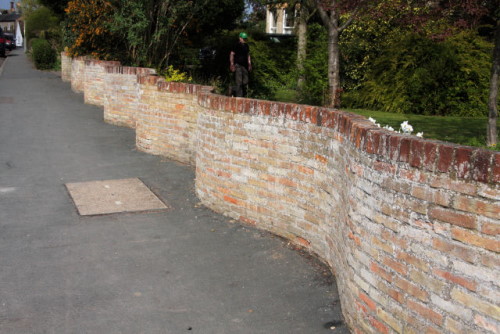
A crinkle crankle wall, also called a serpentine wall, is a wavy wall that may seem to sacrifice some efficiency for aesthetics. The curves add visual interest, but they use more material than a straight wall. Except they don’t! They use more bricks than a straight wall of the same thickness but they don’t have to be as thick.
Crinkle crankle walls resist horizontal forces, like wind, more than straight wall would. So if the alternative to a crinkle crankle wall one-brick thick is a straight wall two or more bricks thick, the former saves material. How much material?
The amount of material used in the wall is proportional to the product of its length and thickness. Suppose the wall is shaped like a sine wave and consider a section of wall 2π long. If the wall is in the shape of a sin(θ), then we need to find the arc length of this curve. This works out to the following integral.
The parameter a is the amplitude of the sine wave. If a = 0, we have a flat wave, i.e. a straight wall, as so the length of this segment is 2π = 6.2832. If a = 1, the integral is 7.6404. So a section of wall is 22% longer, but uses 50% less material per unit length as a wall two bricks thick.
The integral above cannot be computed in closed form in terms of elementary functions, so this would make a good homework exercise for a class covering numerical integration.
The integral can be computed in terms of special functions. It equals 4 E(-a²) where E is the “complete elliptic integral of the second kind.” This function is implemented as EllipticE in Mathematica and as scipy.special.ellipe in Python.
As the amplitude a increases, the arc length of a section of wall increases. You could solve for the value of a to give you whatever arc length you like. For example, if a = 1.4422 then the length is twice that of a straight line. So a crinkle crankle wall with amplitude 1.4422 uses about as many bricks as a straight wall twice as thick.
***
Photo “Crinkle crankle wall, Fulbourn” by Bob Jones is licensed under CC BY-SA 2.0

They’re also lovely. I enjoyed Thomas Jefferson’ serpentine walls during the year I spent at UVA.
This is a fun little article. I’m glad Google recommended it to me (even though it’s not really news).
I’ll be teaching Calc II next semester, after a few years away from it. This will be a great addtion to the course.
Fabulous timing, just a few days ago I had stumbled my way onto Practical Engineering’s video on “weir” design¹ discussing how increasing the aspect ratio of the weir geometry to add length beyond the available channel width via “crumpling” achieved better flow control without moving parts and using fewer materials. And now your post showed up in my inbox at just the right time for me to make the connection that walls are the pneumatic equivalent of weirs and a similar strategy can work here as well.
Wonder if this can be generalized to high aspect ratio designs showing up in other areas like aerodynamics (turbulator tape?), thermodynamics (heat sinks) or mathematics (apparently higher dimensional n-spheres can be thought of as spiky hairballs)
¹https://www.youtube.com/watch?v=YkR79oDAgOg&t=225s
I once read a theory that this design of wall deflected the noise of horse and carts using a cobbled road thereby making it less noisy has anyone also heard of this theory
The biggest advantage is not the small amount of bricks saved, but rather the much higher lateral stability of the wavy wall vs. a straight line. This increased resistance to bending (moment of Inertia) is a function of the area x the distance squared from the neutral axis. It is the reason corrugated roofs resist bending much better than flat sheets. The wider stance also helps to provide support on poor soils that a straight wall would not have. Finally, they have an intrinsically attractive appearance. The downside is their poor use of land area.
At what amplitude are sinusoidal walls both sturdy and cost effective? Is there an ideal amplitude?
The bricklayer must work to a sinusoidal template and plumb from this. But how does the craftsman design an optimum sinusoidal curve? Let’s assume that he cannot do calculus.
That’s an interesting question. These walls exist, so there must be some way they do it.
As a bricky I have built a few over the years and they are an absolute pain to build. Everything has to be uprighted constantly and you obviously can’t pull a line between any fixed points once you’ve set it out.
Even worse on a sloping site….
Less material is actually saving money but looks like there will be extra labor charges for building this type of wall. This might increase the initial cost